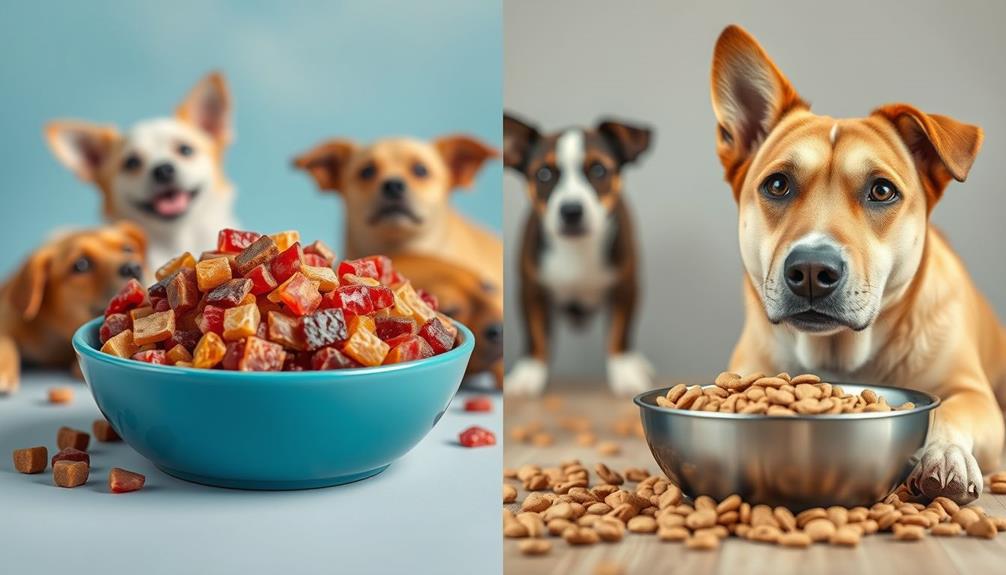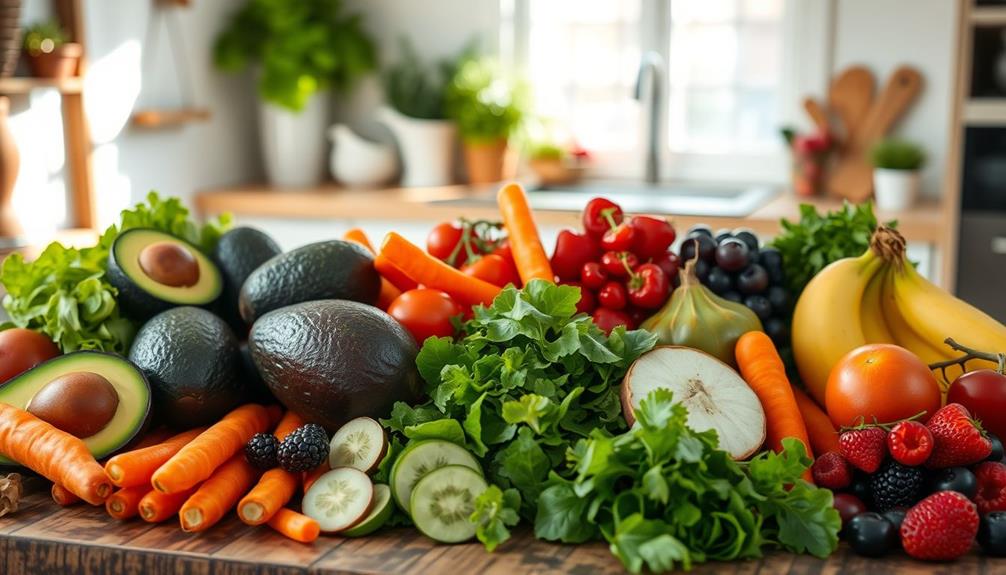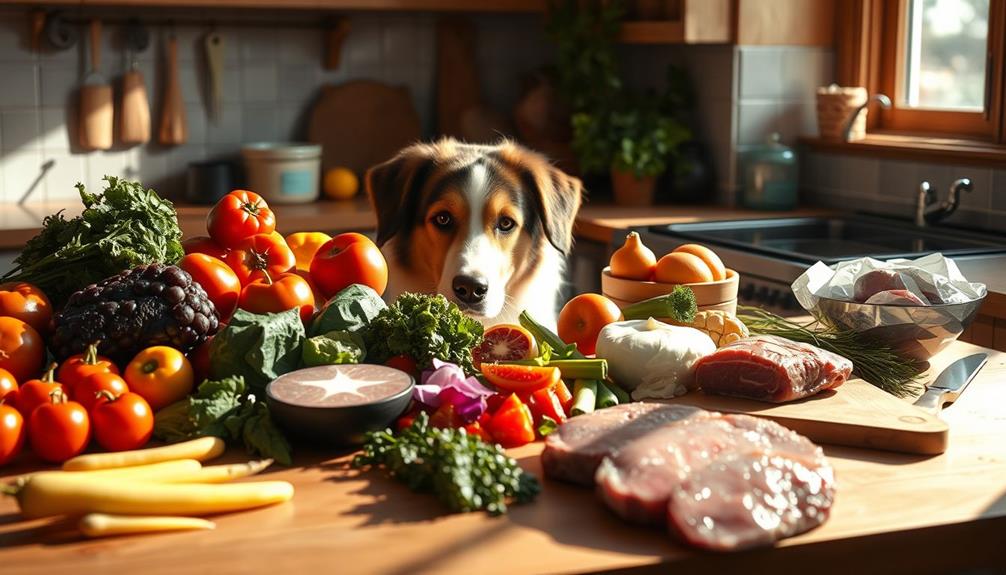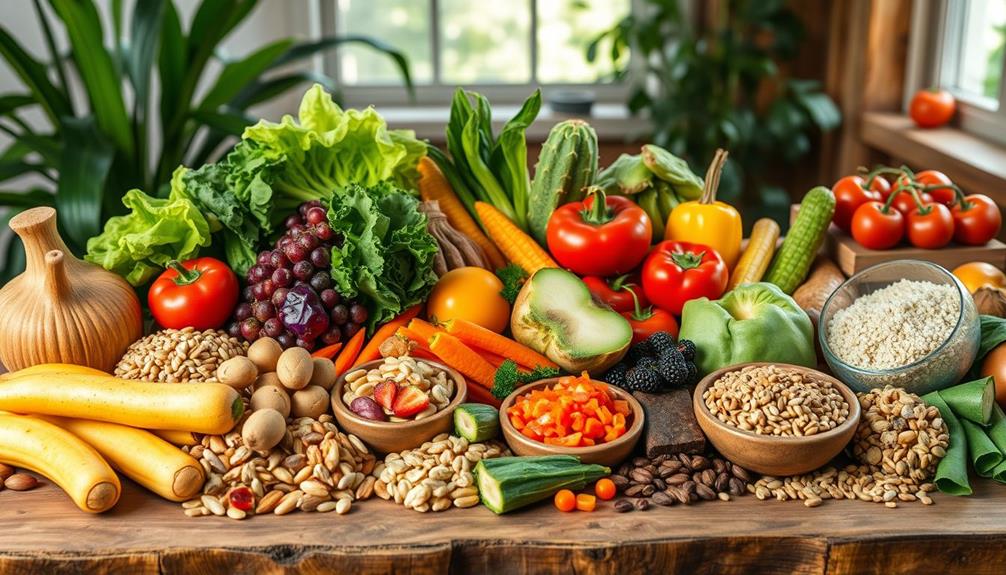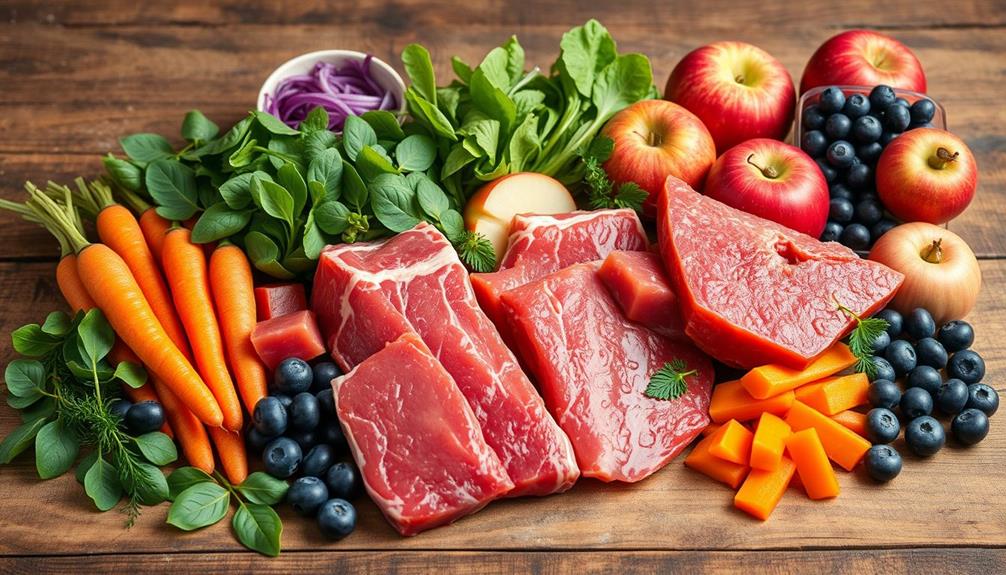Freeze-dried raw food can be a great option for your dog, offering benefits like high protein content and preserved nutrients. Many dogs find it tastier than traditional kibble, and its long shelf life makes it convenient for storage. However, it's not without concerns. There are risks of contamination from harmful bacteria, and some products may lack complete nutrition. Additionally, freeze-dried food tends to be pricier than other options. It's important to choose quality products and consult your vet before making a switch. If you want to know more about the details, keep exploring your options.
Key Takeaways
- Freeze-dried dog food preserves nutritional value while mimicking a natural diet, appealing to many dogs compared to traditional kibble.
- It offers long shelf life and is convenient for storage and travel, but may present contamination risks if not handled properly.
- Many freeze-dried products fail to meet AAFCO standards, potentially leading to nutritional deficiencies for dogs.
- High costs and short shelf life once opened can make freeze-dried options less budget-friendly for pet owners.
- Gradual introduction and proper hydration are essential for transitioning dogs to freeze-dried food to prevent digestive issues.
What Is Freeze-Dried Dog Food?
Freeze-dried dog food is an innovative way to feed your furry friend while preserving the natural goodness of raw ingredients. This type of food undergoes a unique freeze-drying process, where moisture is removed through sublimation. First, the food is frozen, then a vacuum turns the ice directly into vapor, leaving behind a product that contains only 5%-7% moisture.
Many pet owners are also opting for high-quality protein sources in their dog diets, which can lead to improved energy levels and overall health, as seen in healthy dog snacks.
You'll find that freeze-dried dog foods are typically grain-free and high in protein, making them suitable for dogs with specific dietary needs or those adapting to a raw diet. This method retains the taste, smell, and nutritional profile of raw meat, ensuring that your dog enjoys a meal that's both delicious and nutritionally complete.
One of the standout features of freeze-dried dog food is its long shelf life, often lasting from 1 to 5 years when unopened. This convenience makes it easy to store and travel with, so you can keep your pup's meals fresh and accessible.
Unlike dehydrated foods that use heat, freeze-dried options maintain their original structure and nutrients, providing a healthier alternative for you and your dog.
Benefits of Freeze-Dried Dog Food
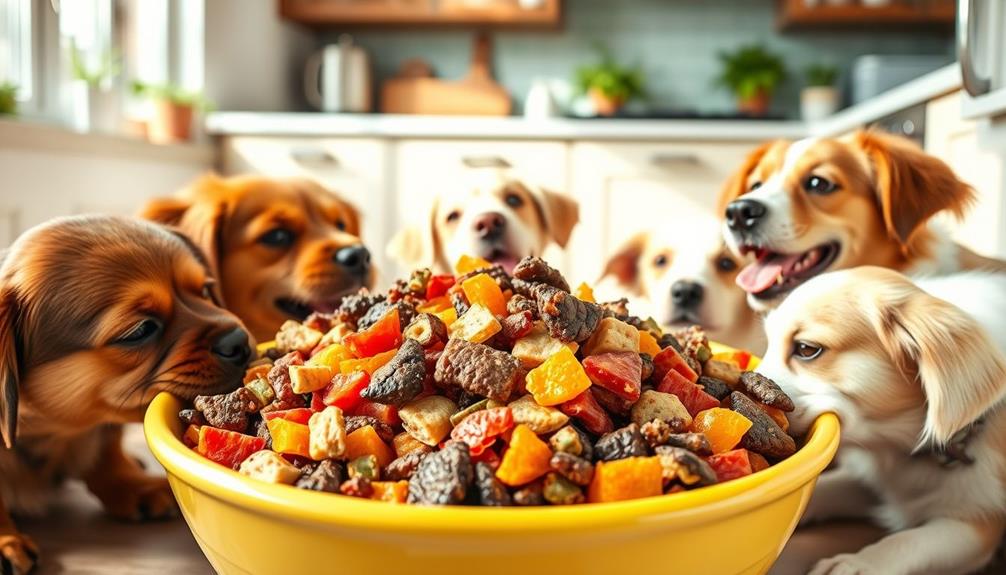
When it comes to feeding your dog, freeze-dried dog food offers numerous benefits that can elevate their mealtime experience. This type of food mimics a natural canid diet, with appealing textures and aromas that most dogs love.
One major advantage is its convenience; being shelf-stable means you don't have to worry about refrigeration, making storage and transportation a breeze. Additionally, the preservation of nutrients through freeze-drying mirrors the benefits of consuming high levels of antioxidants found in other beneficial foods.
The freeze-drying process effectively preserves essential nutrients, ensuring high protein content and crucial amino acids that contribute to your dog's health. By providing a variety of freeze-dried options, you can introduce diverse micronutrients into their diet, which can lead to improved skin health, dental health, and stronger immunity.
Additionally, freeze-dried dog food allows you to offer the benefits of a raw diet without the risks associated with handling raw meat, such as exposure to harmful pathogens. This means you can give your furry friend the wholesome goodness they deserve while keeping safety in mind.
Drawbacks of Freeze-Dried Dog Food
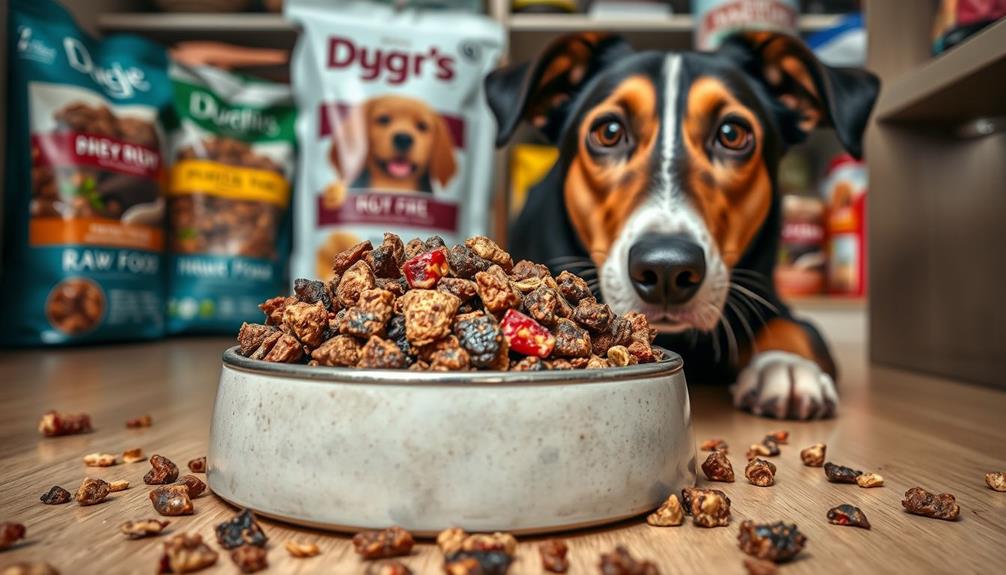
What should you consider before changing your dog to freeze-dried food? While freeze-dried dog food offers some benefits, it also has notable drawbacks that you shouldn't overlook.
To begin with, there's the potential health risks associated with contamination from pathogens like Salmonella and E. coli, which can lead to serious health issues for both your pet and your family. It's essential to maintain proper hygiene when handling these products, as improper storage can exacerbate these risks.
Additionally, some freeze-dried products may not meet AAFCO standards for complete nutrition, which raises concerns about nutritional deficiencies if you rely solely on them for your dog's diet consideration of natural remedies alongside conventional medications.
Another significant factor is the high cost; freeze-dried food typically ranges from $30 to $50 for just a 1 lb bag, making it a less budget-friendly option for many pet owners.
Furthermore, once opened, it has a short shelf life of about four weeks, necessitating careful management to avoid spoilage from moisture.
Finally, the unappealing texture of freeze-dried food can deter picky eaters, often requiring gradual changes or mixing with more familiar foods to encourage acceptance.
Weigh these factors carefully before making the switch.
The Freeze-Drying Process
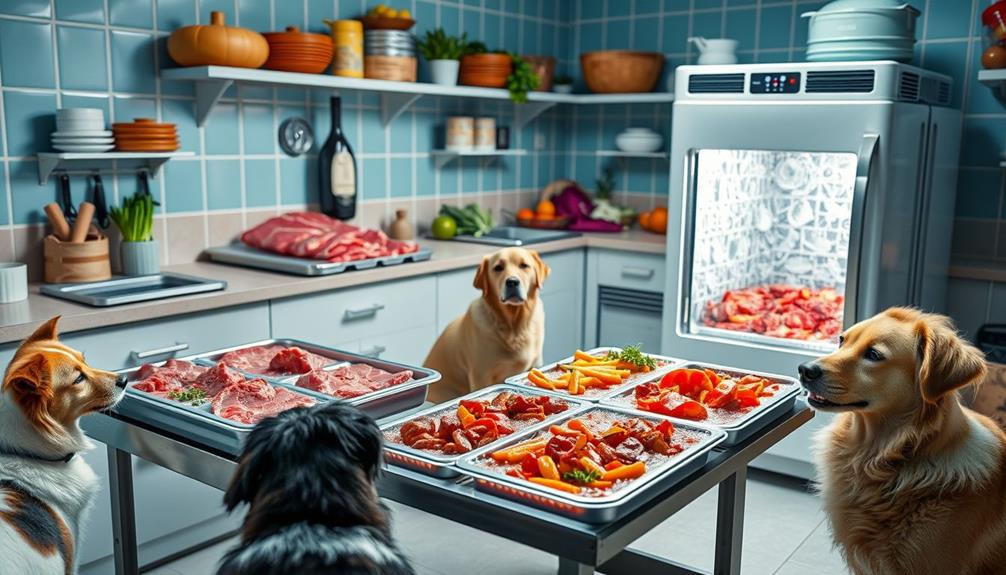
Understanding the freeze-drying process is key to appreciating its benefits for your dog's food. This method freezes the ingredients, removes moisture in a vacuum, and preserves essential nutrients without altering their natural structure or flavor.
Additionally, the absence of preservatives in freeze-dried raw food mirrors the essential oils for health approach, ensuring a more natural diet for your furry friend.
Process Overview
The freeze-drying process is a revolutionary method for preparing raw food for dogs, guaranteeing high-quality nutrition without compromising flavor or structure. It begins by freezing the food to convert water into ice, followed by moisture removal in a vacuum chamber. This unique process allows sublimation, where ice transforms directly into vapor, resulting in freeze-dried dog food that retains its original texture and taste.
Additionally, just like maintaining an air purifier, regular checks on the quality of the freeze-dried food can enhance its nutritional benefits and freshness, similar to how air purifier maintenance guarantees peak performance.
With only 5%-7% moisture compared to 70% in frozen raw foods, freeze-dried options become shelf-stable for years, making them convenient for pet owners. Unlike dehydration, which uses heat, freeze-drying maintains the integrity of the ingredients and their nutritional value. This means your furry friend gets a nutrient-rich meal without sacrificing quality.
The entire process takes about two days, but the benefits are worth the wait. You can feel confident knowing that your dog's food has undergone a method designed to preserve the essential nutrients while guaranteeing safety.
Nutrient Preservation Techniques
Freeze-drying stands out as a leading technique for preserving nutrients in dog food, ensuring that your pet receives a wholesome meal. This process effectively maintains the integrity and nutritional value of the ingredients, similar to how glycolic acid enhances skin texture by promoting cell turnover.
Here are three key benefits of freeze-dried diets:
- Moisture Content: Freeze-dried foods have a moisture content of only 5%-7%, compared to 70% in raw or fresh foods. This notably extends shelf life without sacrificing quality.
- Nutrient Retention: The low-temperature dehydration method minimizes the destruction of essential vitamins and minerals, promoting excellent nutrient preservation compared to traditional cooking methods.
- Food Safety: Many manufacturers use high-pressure pasteurization (HPP) during freeze-drying to eliminate pathogens, ensuring food safety while retaining nutrients.
These advantages make freeze-dried diets not only appealing to dogs due to their taste and appearance but also a smart choice for maintaining their health.
Nutritional Value and Safety

When choosing freeze-dried raw food for your dog, you're opting for a diet that retains high nutritional value, ensuring essential vitamins and minerals stay intact. This method preserves the integrity of ingredients better than traditional cooking methods, allowing your pet to enjoy a grain-free, high-protein diet that aligns with their natural needs.
Additionally, just as regular health screenings like mammography aims to detect health issues early, being proactive about your dog's nutrition can help prevent potential health problems.
However, it's important to reflect on the safety aspect of freeze-dried dog food. While the nutritional benefits are significant, there's a risk of pathogen exposure, including harmful bacteria like Salmonella and E. coli. These pathogens can pose health risks not only to your dog but also to your household.
Some manufacturers utilize high-pressure pasteurization (HPP) to eliminate these harmful bacteria while maintaining food safety. Still, not all freeze-dried products undergo this treatment. Hence, it's vital to research and choose products that prioritize safety.
Additionally, proper handling practices are essential when feeding freeze-dried raw food. Always wash your hands and surfaces after handling the food, and store it correctly to minimize the risk of food-borne illnesses.
Feeding Guidelines for Dogs
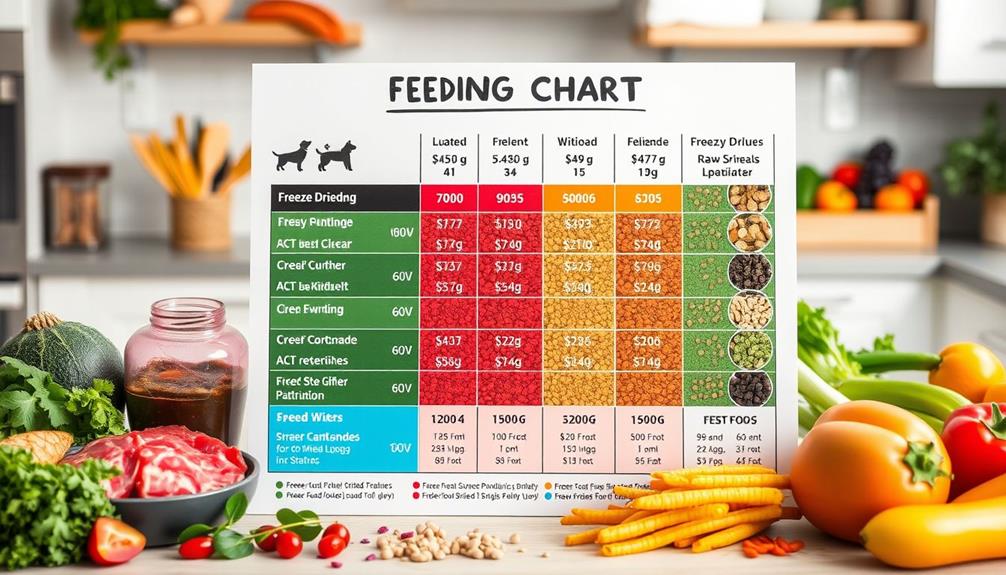
When it comes to feeding your dog freeze-dried raw food, following the package guidelines is key for getting the right daily portions based on their ideal weight.
It's crucial to take into account the nutritional value of the ingredients, as financial considerations for elderly care can also apply to pet care decisions.
Keep in mind that some foods may need rehydration, so check the instructions carefully before serving.
It's also important to monitor your dog's weight and adjust portions as needed to maintain their health.
Daily Portion Recommendations
Finding the right daily portion of freeze-dried raw food for your dog can seem intimidating, but it's all about considering their weight, age, and activity level. Here are three key points to help you determine the right feeding amounts:
1. Weight Guidelines: For adult dogs, aim for about 2-3% of their body weight daily in freeze-dried dog food. Adjust this based on your dog's ideal weight.
It's crucial to confirm that the food you select meets your dog's nutritional needs, similar to the focus on a proper diet for hamsters found in the Ultimate Hamster Care Guide.
2. Rehydration Considerations: Remember, many freeze-dried foods require rehydration. One cup of freeze-dried food can equal approximately 2-3 cups of rehydrated food, so factor this into your daily portion recommendations.
3. Monitoring Health: Regularly monitor your dog's body condition and weight. If they seem to be gaining or losing weight, adjust their feeding amounts accordingly.
When making the shift to freeze-dried raw food, start with smaller portions to help your dog's digestive system adapt. Gradually increase the amount as tolerated.
Hydration and Preparation Tips
Serving freeze-dried raw food to your dog requires a few essential steps to guarantee proper hydration and preparation.
First, always check the package feeding guidelines based on your dog's ideal weight. Adjust portions as necessary for your dog's weight or activity level. Some freeze-dried dog food needs rehydration, while others can be served dry, so make sure to read the specific instructions on the packaging.
Additionally, consider the potential health implications of the food you choose, as some options may have dietary restrictions that could affect your dog's well-being, similar to how ice cream can affect pets if not chosen carefully.
For best texture and palatability, softer freeze-dried options might need soaking in water for a few minutes before feeding. In contrast, harder nuggets can be enjoyed as crunchy treats.
Measuring the feeding amounts based on the dry food state is important since rehydration can alter the volume and caloric content.
Monitoring Weight Changes
Monitoring your dog's weight is vital for guaranteeing their health, especially when feeding freeze-dried raw food. Since these diets require careful portion control, following feeding guidelines is fundamental.
Here are three key points to keep in mind:
- Adjust Portions: Modify the amount you feed based on your dog's ideal weight and activity level.
- Watch for Changes: Regularly check your dog's weight. If you notice any fluctuations, you may need to adjust feeding amounts to maintain a healthy body condition.
- Rehydrate Properly: Since freeze-dried raw food needs rehydration, make certain you're providing enough water to prevent dehydration and support digestion.
Maintaining a consistent feeding schedule helps in evaluating weight changes effectively. This approach guarantees your dog is getting balanced nutrition from their meals.
If you're unsure about the right portions or notice significant weight changes, consult with your veterinarian. They can help you determine the best feeding regimen based on your dog's specific needs and lifestyle changes, guaranteeing your furry friend stays in peak health.
Choosing Quality Freeze-Dried Options
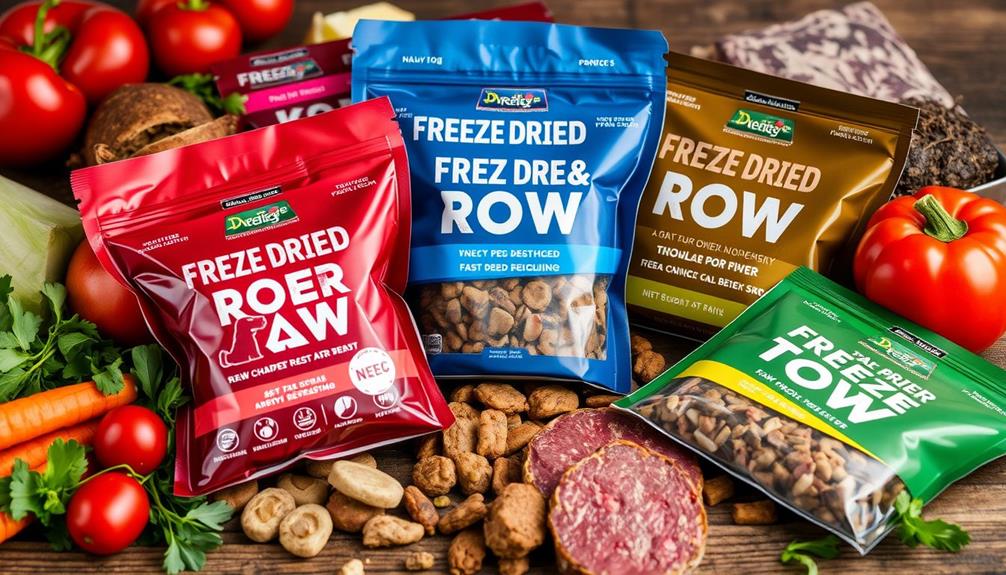
Quality is paramount when it comes to choosing freeze-dried food for your dog. When selecting freeze-dried dog food, make certain it claims to provide complete nutrition and highlights quality ingredients, particularly high-quality animal proteins as the primary components.
Look for options that include organ meats and bones, as these are essential for a well-rounded nutritional profile. They help guarantee your dog gets the vitamins and minerals needed for ideal health.
Additionally, opt for brands that source grass-fed, free-range, or organic meat. This choice assures higher quality and nutritional integrity in their freeze-dried products.
It's also wise to avoid freeze-dried foods with high starch content, as they can lead to nutritional imbalances, making your dog's diet less beneficial.
Lastly, don't underestimate the importance of hygiene practices when handling freeze-dried options. Always wash your hands and surfaces thoroughly to minimize the risk of pathogen exposure.
Transitioning to Freeze-Dried Food
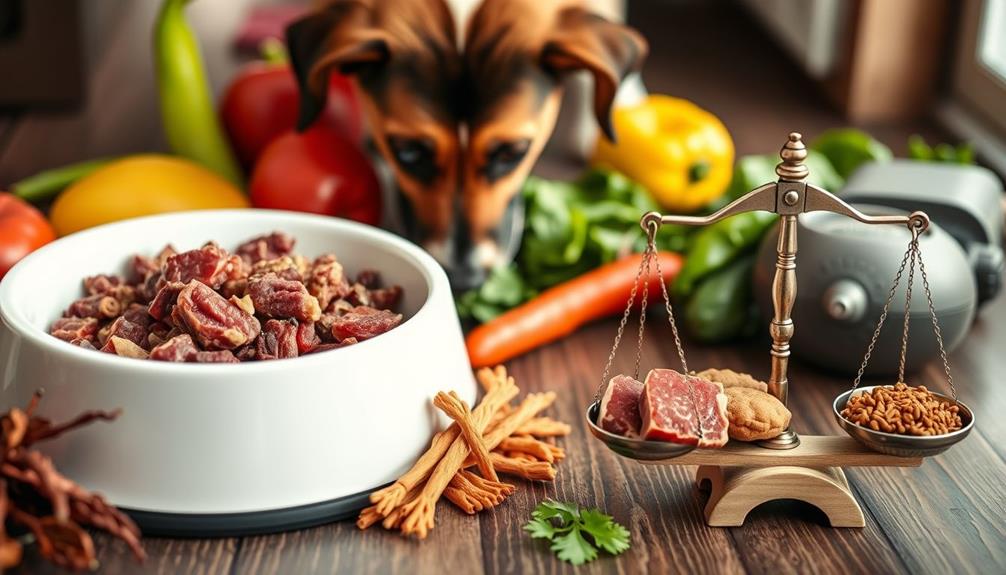
When switching your dog to freeze-dried food, a gradual approach is key to guaranteeing a smooth changeover. Here are three steps to help you with shifting to freeze-dried food:
1. Start Slow: Begin by mixing small portions of freeze-dried food with your dog's current diet.
Increase the amount gradually over a week or two, allowing your dog to adapt to the new flavors and textures.
2. Rehydrate for Acceptance: Rehydrating freeze-dried food can enhance its palatability.
Dogs often prefer the familiar texture of wet food, making it easier for them to accept the new diet.
3. Monitor Your Dog's Reaction: Keep a close eye on how your dog responds during the shift.
Some dogs may take longer to adjust, especially if they've sensitive stomachs or are picky eaters.
Before making any significant dietary changes, consult your veterinarian to guarantee the new freeze-dried food meets your dog's nutritional needs.
This careful approach can help facilitate a healthy shift, minimizing the risk of digestive upset along the way.
Expert Opinions on Freeze-Dried Diets
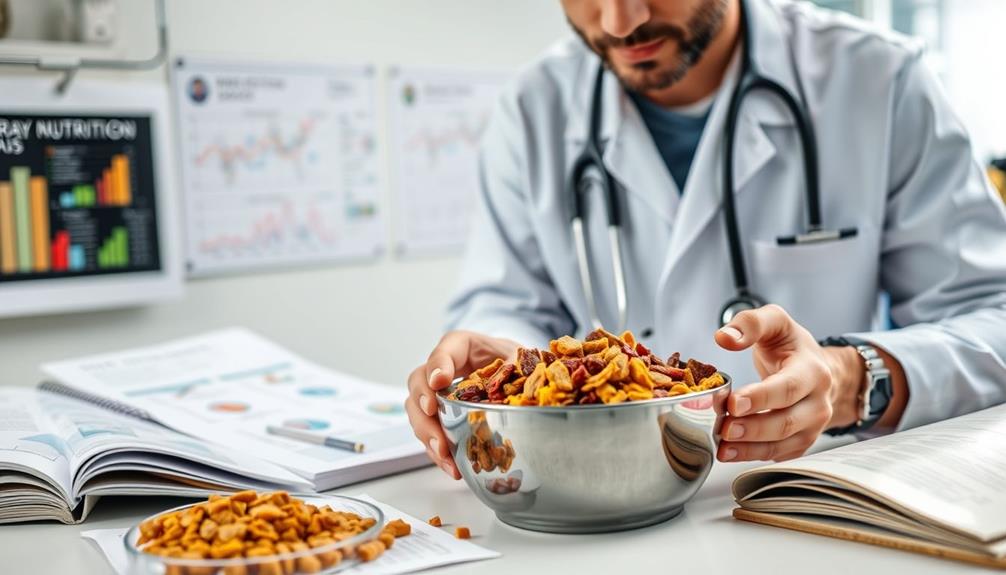
The debate surrounding freeze-dried diets for dogs highlights the importance of careful consideration. While freeze-dried dog food offers convenience and may appeal to you, expert opinions are mixed about its overall health benefits. Many veterinarians caution that there's insufficient evidence to prove these diets are superior to traditional ones.
One major concern is the risk of contamination with pathogens like Salmonella and E. coli, which can endanger both your dog and your household. Additionally, studies show that many freeze-dried and raw diets fall short of AAFCO standards for complete and balanced nutrition. This raises questions about whether these diets adequately meet your dog's nutritional needs.
Experts strongly recommend consulting with your veterinarian before making any changes to your dog's diet. They can help you navigate the complexities of freeze-dried options and guarantee your furry friend receives all essential nutrients.
While some pet owners may find freeze-dried foods more palatable and nutrient-dense, the potential safety issues and handling requirements can often overshadow these benefits. So, weigh the pros and cons carefully before deciding on a freeze-dried diet for your dog.
Additional Resources and References
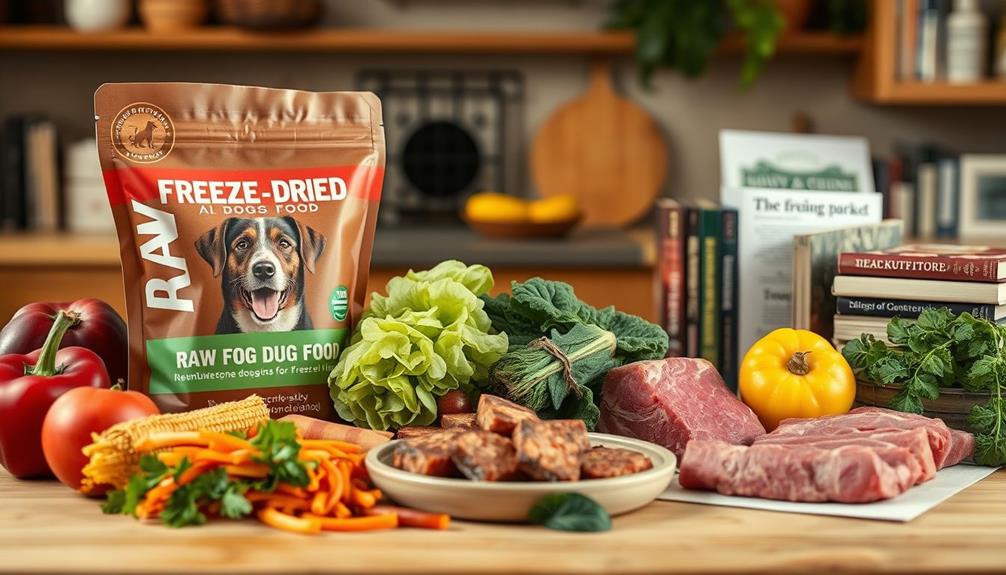
When considering freeze-dried raw food for your dog, it's crucial to assess the nutritional quality and guarantee safe handling practices. There are several factors to consider when evaluating the nutritional quality of freeze-dried raw dog food options, such as the balance of protein, fats, and carbohydrates, as well as the presence of essential vitamins and minerals. It’s also important to ensure that the manufacturer follows safe handling practices during the production and packaging of the food to minimize the risk of contamination. By carefully assessing these factors, you can make an informed decision about which freeze-dried raw dog food option is best for your furry friend.
You'll want to rely on reputable resources for guidance on balancing your pet's diet while minimizing health risks.
Let's explore the best strategies for making informed decisions about these diets.
Nutritional Quality Assessment
Evaluating the nutritional quality of freeze-dried raw food for dogs is fundamental for ensuring your pet's health. While freeze-dried dog food can be a convenient option, it's important to understand its nutritional profile. Here are a few key points to keep in mind:
- Nutrient Density: The freeze-drying process enhances nutrient density, preserving essential vitamins and minerals that cooking may destroy. This means your dog can receive high-quality nutrition.
- AAFCO Standards: Be aware that many freeze-dried options may lack complete nutrition. Studies show over 60% of tested raw diets don't meet AAFCO standards, so careful ingredient selection is significant.
- Food Safety: Although freeze-dried foods are shelf-stable, they can still pose food safety risks, such as contamination from pathogens like Salmonella or E. coli. Proper handling and storage are important to mitigate these risks.
Consulting with a veterinarian is fundamental when choosing freeze-dried diets. They can help assess the nutritional adequacy of specific products and recommend suitable options based on your dog's health needs.
Prioritize your pup's well-being by choosing high-quality freeze-dried dog food that meets their nutritional requirements.
Safety and Handling Guidelines
Ensuring safety and proper handling of freeze-dried raw food for dogs is essential for preventing health risks. Start by practicing good hygiene; always wash your hands and disinfect surfaces before and after handling the food. This helps prevent cross-contamination with harmful pathogens like Salmonella and E. coli.
Follow the manufacturer's guidelines for storage and usage. Once opened, use the freeze-dried dog food within four weeks to maintain its safety and nutritional quality.
To help your dog adjust, gradually incorporate the new food into their diet and monitor for any adverse reactions or digestive issues.
It's vital to consult with a veterinary professional before introducing freeze-dried raw food, ensuring it meets your dog's specific health needs and dietary requirements.
Keep the freeze-dried products sealed and stored in a cool, dry place to extend their shelf life and protect them from moisture exposure, which can compromise food quality.
Frequently Asked Questions
Is Freeze-Dried Raw Diet Good for Dogs?
When considering a freeze-dried raw diet for your dog, remember it offers convenience and high protein. However, you need to guarantee it meets all nutritional needs while avoiding potential contamination risks. Always consult your vet.
What Are the Disadvantages of Freeze-Dried Food?
Have you considered the downsides of freeze-dried food? It's often pricey, can lack full nutrition, may harbor pathogens, spoils quickly, and picky eaters might not even like its texture. It's worth weighing these factors!
Which Is Better for Dogs, Dehydrated or Freeze-Dried?
When choosing between dehydrated and freeze-dried food for your dog, consider freeze-dried options. They retain more nutrients, flavors, and textures, making them tastier and easier to digest. Plus, they're shelf-stable and convenient for storage.
Why Is Freeze-Dried Raw Dog Food so Expensive?
Imagine crafting gourmet meals at home; that's similar to freeze-dried dog food's process. Its high cost stems from specialized equipment, premium ingredients, and time-consuming methods, making it pricier than traditional kibble but nutritionally dense.
Conclusion
In the grand tapestry of dog nutrition, freeze-dried raw food can be a vibrant thread, weaving together convenience and quality. While it offers a treasure trove of nutrients, it's crucial to weigh the pros and cons before diving in. Your pup deserves the best, so take the time to choose wisely and shift thoughtfully. With the right approach, you can open a world of flavors and health that your furry friend will relish with every bite.

